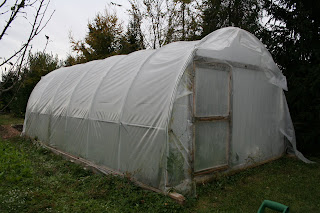Doom and Gloom: Triage
As I had previously posted, one of the several books I am working my way through is James Martin's The Meaning of the 21st Century and I am finding it a fantastic thought provoker. Most of his book is spent talking about solutions to the problems we face in the current Generation and offering clear vision to how to implement them, but several of his portraits of the mid near
 future (say 25-50 years out) are dark. He calls it The Canyon. Those of us familiar with the The Natural Step would term it the Resource Funnel. The funnel is currently closing as the demand for resources rises and the availability of resources (including such vital things as clean water and topsoil, not just oil and n. gas...). It is most often depicted as it is at right: with the lines not touching. Basically that The World wakes up before it gets ugly.
future (say 25-50 years out) are dark. He calls it The Canyon. Those of us familiar with the The Natural Step would term it the Resource Funnel. The funnel is currently closing as the demand for resources rises and the availability of resources (including such vital things as clean water and topsoil, not just oil and n. gas...). It is most often depicted as it is at right: with the lines not touching. Basically that The World wakes up before it gets ugly.The reality is that when we are approached with a slowing growing, easily rationalized or otherwise nebulous threat we typically do nothing until the crisis occurs and removes all doubt. Two easy, recent examples would be the Cod Fishery off Newfoundland, and Hurricane Katrina. In both cases scientists, engineers and enlightened citizens decried the impending doom or either a collapsing fishery or blown levies, but in each case enough smoke was blown to forestall action until the Crisis Hit. Then in the case of the fishery at least massive legislation was instituted. Each of these cases were avoidable, the science to correct them known, and an early fix would have been immensely cheaper then correcting from the Crisis. These cases were also regional and for the most part only involving one country. Take the case of Global Warming, Peak Oil, or Global Population, and I am in my darker moments I am forced to the conclusion that we will not, perhaps cannot, react until it is far too late-until after the Crisis.
Martin's Triage scenario fits my vision when I am that dark. Triage is a way to assess those who are in need of medical attention after an extreme event-when the victims are far in excess of the medical providers resources to handle them. Triage is a way to roughly and callously (realistically?) group the victims by the ability to be treated to attempt to save the most victims possible without wasting precious effort on the Doomed. When we enter Martin's Canyon, or when we let the sides of the funnel cross, we will be undergoing a Crisis that could very well force the planet's nations into Triage. The 1st world will be shaken and bloody, but will almost certainly survive-America did not see mass starvation even in the Depression. The rate of survival without disability will fall quickly as you enter the 2nd world, and by the time you reach the 4th world-where people are already starving-there will simply not be resources left to feed them all. The 1st world has the money to buy the food, regardless of cost. Hell, we even use food to power our cars. This scenario can be avoided with current technology, the scientific community-even the oil engineers-are telling us it is coming. And yet we will most likely do nothing until the cod runs out.
I usually don't go this Doom and Gloom-neither here in the Blog nor in my actual life. But this morning I was at my son's school. In the hallway after the assembly there was one of Sprout's classmates that is in a mechanized wheelchair and is very severely handicapped. Again, I am in a Dark place now, but when I got home I wept. When Triage hits the 1st world civilization will survive, but there are many shades within even our uber affluent society.
I have made it a mission to learn what is necessary to be able to feed my family, even my neighbors, once it Gets Bad. But how will this boy, or the thousands like him, manage?
We must do better.
Labels: Doom and Gloom, going off
 Stumble It!
Stumble It!




 The compost is about 200 yards from the hoop house, but 5 trips with Archimedes (my 10 cu ft barrow) and I had enough to cover the comfrey with a 2" layer to coax the worms to the feast.
The compost is about 200 yards from the hoop house, but 5 trips with Archimedes (my 10 cu ft barrow) and I had enough to cover the comfrey with a 2" layer to coax the worms to the feast.













